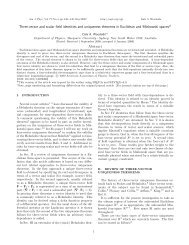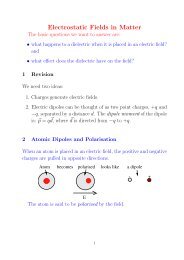Chapter 8 Vector Spaces in Quantum Mechanics
Chapter 8 Vector Spaces in Quantum Mechanics
Chapter 8 Vector Spaces in Quantum Mechanics
You also want an ePaper? Increase the reach of your titles
YUMPU automatically turns print PDFs into web optimized ePapers that Google loves.
<strong>Chapter</strong> 8 <strong>Vector</strong> <strong>Spaces</strong> <strong>in</strong> <strong>Quantum</strong> <strong>Mechanics</strong> 88applied to any physical system so as to generate a quantum description of such a system.We do this by not<strong>in</strong>g the s<strong>in</strong>gular role played <strong>in</strong> the above discussion of the ’<strong>in</strong>termediatestates’. If we can identify such <strong>in</strong>termediate states for any physical system, then we are <strong>in</strong>a position to formulate a quantum description of such a system.The characteristics of the <strong>in</strong>termediate states that are of greatest importance are the follow<strong>in</strong>g:1. They represent mutually exclusive alternatives, that is, if a measurement is made, asystem is observed <strong>in</strong> only one of these possible <strong>in</strong>termediate states;2. The <strong>in</strong>termediate states cover all possibilities, that is, if a measurement is made, thesystem is always observed to be <strong>in</strong> one of these <strong>in</strong>termediate states;3. If the system is <strong>in</strong>itially prepared <strong>in</strong> some <strong>in</strong>itial state |ψ〉, then the probability amplitudeof observ<strong>in</strong>g it <strong>in</strong> some arbitrary f<strong>in</strong>al state |φ〉 is given by a sum of probabilityamplitudes of pass<strong>in</strong>g through each of these <strong>in</strong>termediate states, <strong>in</strong> a manneranalogous to Eq. (8.48).We will now see how these ideas can be applied to more−a +a−general k<strong>in</strong>ds of physical systems. To beg<strong>in</strong>, we haveOO to set up these <strong>in</strong>termediate states for a given system.So suppose we perform an exhaustive series of measurementsof some observable property of the system| + a〉– call it Q. For example, we could determ<strong>in</strong>e through−a +aO −which slits it is possible for an electron to pass <strong>in</strong> theO two slit experiment above, or the possible values of theZ component of the sp<strong>in</strong> of a particle, or the possible| − a〉values of the position of an electron on an O − 2ion, as <strong>in</strong>the adjacent figure. We will give many more examplesFigure 8.3: O − 2ion with the two later. Whatever the system, what we mean by exhaustiveis that we determ<strong>in</strong>e all the possible values that thepossible positions of the electron, correspond<strong>in</strong>gto the two states | ± a〉. observed quantity Q might have. For <strong>in</strong>stance, we determ<strong>in</strong>ethat, <strong>in</strong> the two slit <strong>in</strong>terference experiment, theelectron can pass through, (that is, be observed to be at) the position of one or the otherof the two slits, or that a sp<strong>in</strong> half particle would be observed to have either of the valuesS z = ± 1, and no other value. Or for the 2 O− 2ion, the electron can be found either on theatom at position x = −a or on the atom at position x = +a. In general, for an arbitraryobservable Q, let us represent these observed values by q 1 , q 2 , q 3 , . . . all of which will bereal numbers. Of course, there might be other observable properties of the system that wemight be able to measure, but for the present we will suppose that we only need concernourselves with just one.In keep<strong>in</strong>g with the way that we developed the idea of state earlier, we then say that as aresult of the measurement produc<strong>in</strong>g, for <strong>in</strong>stance, the outcome q 1 , we then say that thesystem ends up <strong>in</strong> the state |q 1 〉, and similarly for all the others possibilities. Moreover,there is now the possibility, if the system is <strong>in</strong>itially prepared <strong>in</strong> the <strong>in</strong>itial state |ψ〉, ofobserv<strong>in</strong>g it <strong>in</strong> any one of these states |q n 〉, but once aga<strong>in</strong>, we are unable to predict withcerta<strong>in</strong>ty which of these states we will observe the system to be <strong>in</strong> – we can only assign
















